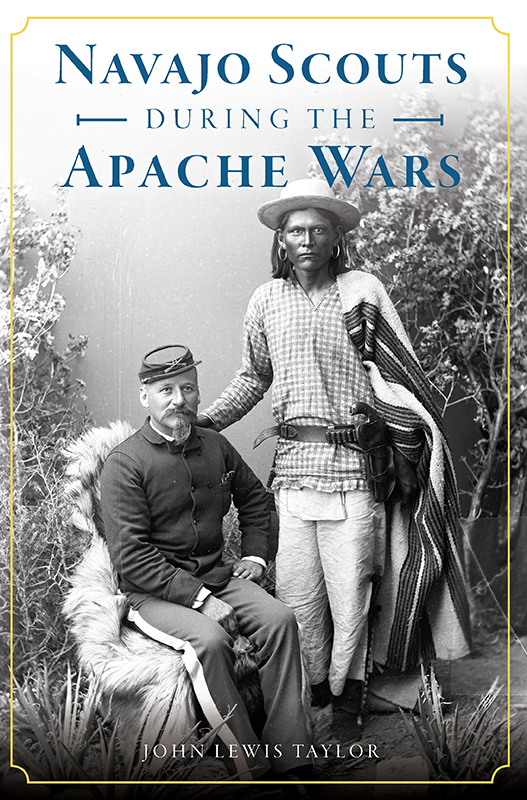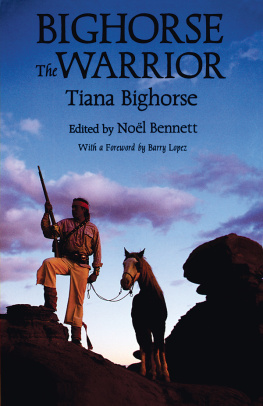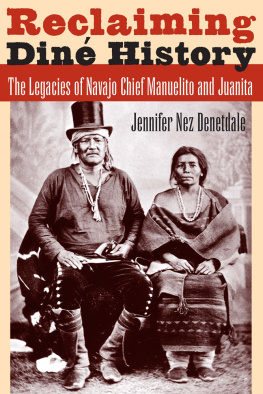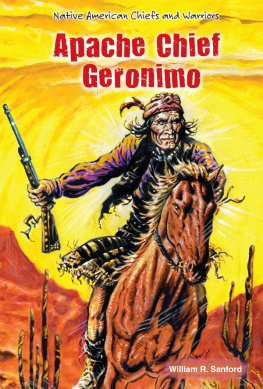

Published by The History Press
Charleston, SC
www.historypress.com
Copyright 2019 by John Lewis Taylor
All rights reserved
First published 2019
e-book edition 2019
ISBN 978.1.43966.750.7
Library of Congress Control Number: 2019937043
print edition ISBN 978.1.46714.195.6
Notice: The information in this book is true and complete to the best of our knowledge. It is offered without guarantee on the part of the author or The History Press. The author and The History Press disclaim all liability in connection with the use of this book.
All rights reserved. No part of this book may be reproduced or transmitted in any form whatsoever without prior written permission from the publisher except in the case of brief quotations embodied in critical articles and reviews.
CONTENTS
FOREWORD
One of the unique aspects in the annals of American warfare is the long and continuous involvement of Native American warriors in our countrys wars. And the role of the Navajos in this important piece of American history is a fascinating story focusing on the closing years of the nineteenth century.
That story actually had its beginnings on July 3, 1775, at Cambridge Commons, when General George Washington assumed command of all the forces composing the first army of the thirteen American colonies. As the various units passed in review, there was a company of Stockbridge Indians from Massachusetts, in feathers, paint and nakedness, commented Washington.
From the early settlement period along the Atlantic seaboard and also in the Spanish conquest in the Southwest, natives served often and effectively as allies of the governments that, ironically, were in the process of conquering their lands and tribes.
Members of various eastern tribes fought in the War of 1812 and the Mexican-American War. Both as scouts and as regular soldiers on both sides of the Civil War, Native Americans fought so well that when Congress enacted legislation reorganizing the federal armed forces for postwar purposes in 1866, it authorized the enlistment of one thousand Native American scouts on the western frontier.
Almost half that numberconsisting mainly of Crow, Shoshoni, Pawnee, Arapaho, Sioux and Cheyenne warriorsserved throughout the numerous campaigns in the mountains and northern plains during the 1870s and 1880s.
During that same period, campaigns were also undertaken against the several Apache tribes located in the high desert and mountains of the Southwest. Military leaders, including General Crook and General Miles, soon learned that sometimes only an Indian could catch an Indian. Although both commanders used Apache scouts, their major reliance was on the recruitment of Navajos, who knew the area, spoke a similar dialect of the Athabaskan language common to all the Apache tribes and had just returned to their ancestral homeland from four years of enforced captivity in eastern New Mexico.
By 1871, with the completion of Fort Wingate, which then served as the military headquarters for the region encompassing the territories of western New Mexico and eastern Arizona, young Navajos answered the call to military service. A hundred or so actually signed up for service in a company of cavalry, and they not only participated in regular army functions but also policed their own Navajo people, dealing with lawbreakers and livestock rustlers.
But many more, including two women, enlisted as regular troopers or scouts during the dozen years of the violent Apache Wars. Hundreds of Navajos performed to the best of their abilities and, with the experiences gained, went on to be political leaders, medicine men or successful ranchers. However, serving as a scout or trooper was no picnic, and all these Navajo soldiers risked their health, well-being and even their lives in performance of their duties.
If you ever have the opportunity to visit the restored buildings of Fort Apache, in east-central Arizona, be sure to follow the path to the post cemetery. The first headstone you will come upon is the burial of Navajo Bill, a young Navajo scout who had been killed in action while his unit was assigned to Fort Apache.
MARTIN LINK
ACKNOWLEDGEMENTS
I would like to thank two of my professors in the history department at Western Kentucky University, Dr. Jack Thacker and Dr. James Bennet. When I was an undergraduate student there in the late 1960s, they awakened my interest in the history of the American West and the United States military. Without the memory of their mentorship in historical research, I do not think I would have been so bold as to attempt to write this work.
I have had a great deal of help in developing this narrative about Navajo scouts and the role of the Navajo people (Din) in the story of the Southwest. I would like to thank former library director Mary Ellen Pellington, current director Tammie Moe and the staff at the Octavia Fellin Library in Gallup, New Mexico, for their support in helping me find the necessary resources. The Octavia Fellin Library is a treasure-trove of material on the Southwest and its peoples. I also wish to acknowledge the New Mexico History MuseumPalace of the Governors Photo Archives and its photo curator, Daniel Kosharek. The Navajo Nation Museum; its former archivist, Claendra Begay; and its current archivist, Ben Sorrell, along with the Navajo Nation Librarys Linda Curtis, were all an immense help in the gathering of information. Also, thanks to Dr. William Dodge and Martin Link, who read early drafts of the text and made wise comments concerning organization of the chapters. I would also like to extend my appreciation to my sister, Marlane Taylor, who prepared the final draft, and to my wife, Betty, who is a descendent of a Navajo scout.
Chapter 1
SETTLER NATIONS MILITARIES AND THE INDIAN NATIONS
Since the very beginning of European colonization, the colonial powers used native peoples, either as individuals or as nations, as allies against other colonial settlers or native peoples. European powers soon learned that Native American scouts and soldiers were essential to maintaining their hold on colonial interests in North America.
During its struggle for independence from England, the American colonies continued the use of native combatants. Beginning in 1775, the American army used native peoples in its ranks; however, the military rarely allowed native peoples to serve as members of the regular United States forces.
There were exceptions. David Moniac, a member of the Creek Nation from Mississippi Territory, graduated from the United States Military Academy at West Point in June 1822, receiving a commission as second lieutenant in the Sixth United States Infantry. He resigned his commission in December of that year and returned to his plantation in Alabama. In November 1836, Moniac returned to active duty, was promoted to major and was given command of a unit of Creek volunteers.
Major Moniac was killed in action while leading his Creek troops in a frontal assault on the Seminoles at the Battle of Wahoo Swamp, in todays Sumter County, Florida.
When the Civil War began, many American Indians chose to take part. Those who supported the United States were enlisted as home guards or scouts in volunteer units, serving along the western border lands and the Indian Territory.
For a Native American to become an officer in the regular United States Army, it was more difficult than serving in a volunteer regiment. In 1861, Ely Parker, citizen of the Iroquois Nation, offered to raise a regiment of Iroquois volunteers to serve the Union cause. He was told by Edwin D. Morgan, the governor of New York, that Indians were not wanted in the New York Volunteers. Parker then offered his service to the Federal government as an engineer. Parker was refused again, by Secretary of War William Seward, who informed Parker that the fight must be settled by white men alone. Go home and cultivate your farm, Seward said, we will settle our troubles without Indian aid.
Next page





